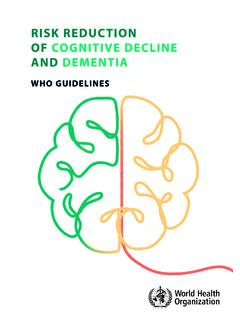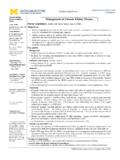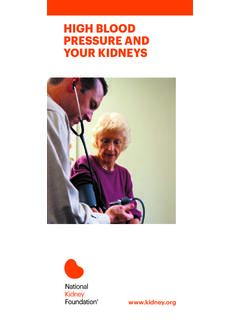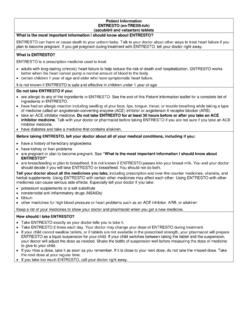Transcription of Drug Dosing Adjustments in Patients with Chronic Kidney ...
1 drug Dosing Adjustments in Patients with Chronic Kidney DiseaseMYRNA Y. MUNAR, PharmD, BCPS, and HARLEEN SINGH, PharmD Oregon State University College of Pharmacy, Portland, Oregon The National Kidney Foundation Kidney Disease Outcomes Quality Initiative (K/DOQI) definition of Chronic Kidney disease is the pres-ence of Kidney damage or a reduction in the glomerular filtration rate (GFR) for three months or longer. The K/DOQI Chronic Kidney disease staging system (Table 1) is based on Dosing in Patients with Chronic Kidney disease can cause toxicity or ineffective therapy.
2 In particular, older Patients are at a higher risk of develop-ing advanced disease and related adverse events caused by age-related decline in renal function and the use of multiple medica-tions to treat comorbid conditions. Chronic Kidney disease can affect glomerular blood f low and filtration, tubular secretion and reabsorption, and renal bioactivation and metabolism. drug absorption, bioavailabil-ity, protein binding, distribution volume, and nonrenal clearance (metabolism) also can be altered in these Patients . Physicians should pay careful attention when consid-ering drug therapies with active or toxic metabolites that can accumulate and con-tribute to exaggerated pharmacologic effects or adverse drug reactions in Patients with Chronic Kidney disease.
3 Table 2 includes resources for more information about dos-ing Adjustments in Patients with Chronic Kidney GFR and Creatinine ClearanceDosages of drugs cleared renally are based on renal function (calculated as GFR or creati-nine clearance; Table 3). These calculations are valid only when renal function is stable and the serum creatinine level is K/DOQI clinical practice guideline advocates using the traditional Cockcroft-Gault equation or the Modification of Diet in Renal Disease (MDRD) study equation (full or abbreviated) for routine estimation of However, in Patients with a GFR lower than 60 mL per minute per m2, the MDRD equation has been shown to be superior to the Cockcroft-Gault the production and excretion of creatinine declines with age, normal serum creatinine values may not represent normal renal function in older Patients .
4 The MDRD equation has been shown to be the best method for detecting a GFR lower than 90 mL per minute per m2 in older Kidney disease affects renal drug elimination and other phar-macokinetic processes involved in drug disposition ( , absorption, drug distribution, nonrenal clearance [metabolism]). drug Dosing errors are common in Patients with renal impairment and can cause adverse effects and poor outcomes. Dosages of drugs cleared renally should be adjusted according to creatinine clearance or glomerular filtration rate and should be calculated using online or electronic calculators. Recommended methods for maintenance Dosing adjust-ments are dose reductions, lengthening the Dosing interval, or both.
5 Physicians should be familiar with commonly used medications that require dosage Adjustments . Resources are available to assist in Dosing decisions for Patients with Chronic Kidney disease. (Am Fam Physician 2007;75:1487-96. Copyright 2007 American Academy of Family Physicians.) This article exemplifies the AAFP 2007 Annual Clinical Focus on manage-ment of Chronic BY ScOTT BOdeLLDownloaded from the American Family Physician Web site at Copyright 2007 American Academy of Family Physicians. For the private, noncommercial use of one individual user of the Web site. All other rights reserved.
6 Contact for copyright questions and/or permission American Family Physician Volume 75, Number 10 May 15, 2007 Kidney Disease: DosingDosing AdjustmentsLoading doses usually do not need to be adjusted in Patients with Chronic Kidney dis-ease. Published guidelines suggest methods for maintenance Dosing Adjustments : dose reduction, lengthening the Dosing interval, or Dose reduction involves reducing each dose while maintaining the normal Dosing interval. This approach maintains more constant drug concentrations, but it is associated with a higher risk of toxicities if the Dosing interval is inadequate to allow for drug elimination.
7 Normal doses are main-tained with the extended interval method, but the Dosing interval is lengthened to allow time for drug elimination before redosing. Lengthening the Dosing interval has been associated with a lower risk of toxicities but a higher risk of subtherapeutic drug concentrations, especially toward the end of the Dosing recommendations for individual drugs can be found in drug Prescribing in Renal Failure: Dosing Guidelines for The guidelines are divided into three broad GFR categories (less than 10 mL per minute per m2, 10 to 50 mL per minute per m2, and more than 50 mL per minute per m2), encompassing an up to 10-fold range in renal function.
8 The guidelines do not correspond with the K/DOQI stag-ing system; therefore, although they can be used for initial dosages, regimens must be individualized further based on patient response and serum drug Dosing requirements for antihyperten-sives in Patients with Chronic Kidney disease are listed in Table ,5 Thiazide diuretics are first-line agents for treating uncompli-cated hypertension,6 but they are not recom-mended if the serum creatinine level is higher than mg per dL (220 mol per L) or if the creatinine clearance is lower than 30 mL per ,8 Loop diuretics are most com-monly used to treat uncomplicated hyperten-sion in Patients with Chronic Kidney Although the addition of aldosterone blockers ( , spironolactone [Aldactone], eplerenone [Inspra]) has been shown to reduce mortal-ity in Patients with severe heart failure,9,10 potassium-sparing diuretics and aldosterone blockers should be avoided in Patients with severe Chronic Kidney disease because of the rise in serum potassium that typically accom-panies renal.
9 KEy RECOMMEnDAtiOns FOR pRACtiCEClinical recommendationEvidence ratingReferencesIn Patients with Chronic Kidney disease, over-the-counter and herbal medicine use should be assessed to ensure that medications are indicated; medications with toxic metabolites should be avoided, the least nephrotoxic agents should be used, and alternative medications should be used if potential drug interactions , 21, 25, 30, 36, 43 Physicians should be aware of drugs with active metabolites that can exaggerate pharmacologic effects in Patients with renal of drugs cleared renally should be adjusted based on the patient s renal function (calculated as creatinine clearance or glomerular filtration rate); initial dosages should be determined using published guidelines and adjusted based on patient response.
10 Serum drug concentrations should be used to monitor effectiveness and toxicity when 1, 4 A = consistent, good-quality patient-oriented evidence; B = inconsistent or limited-quality patient-oriented evidence; C = consensus, disease-oriented evidence, usual practice, expert opinion, or case series. For information about the SORT evidence rating system, see page 1430 or 1. national Kidney Foundation K/DOQi staging system for Chronic Kidney DiseaseStageDescriptionGFR (mL per minute per m2)1 Kidney damage with normal or increased GFR 902 Kidney damage with a mild decrease in GFR60 to 893 Moderate decrease in GFR30 to 594 Severe decrease in GFR15 to 295 Kidney failure< 15 (or dialysis)note: Chronic Kidney disease is defined as the presence of Kidney damage or a reduc-tion in GFR for a period of three months or = Kidney Disease Outcomes Quality Initiative; GFR = glomerular filtration with permission from National Kidney Foundation.














